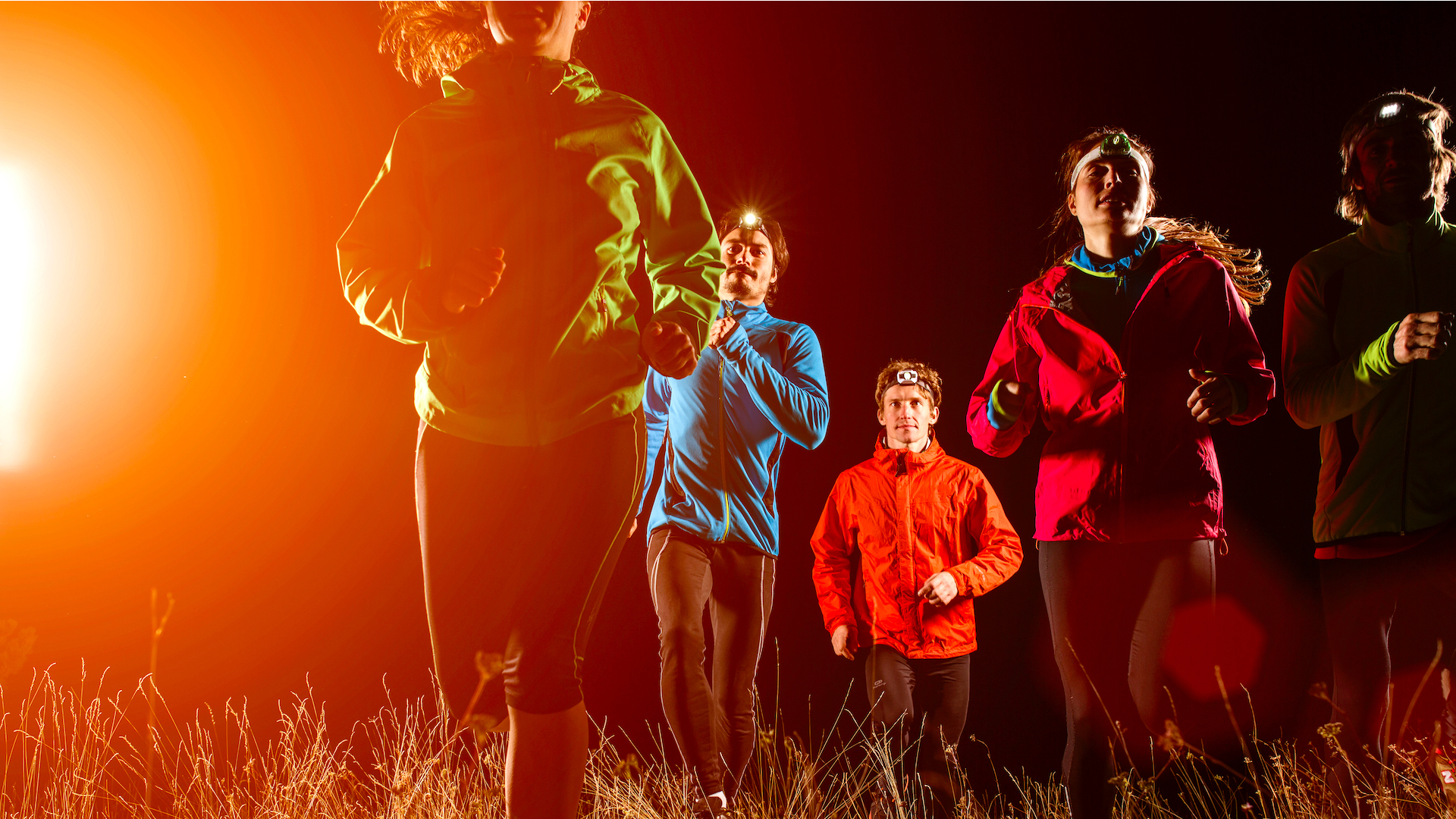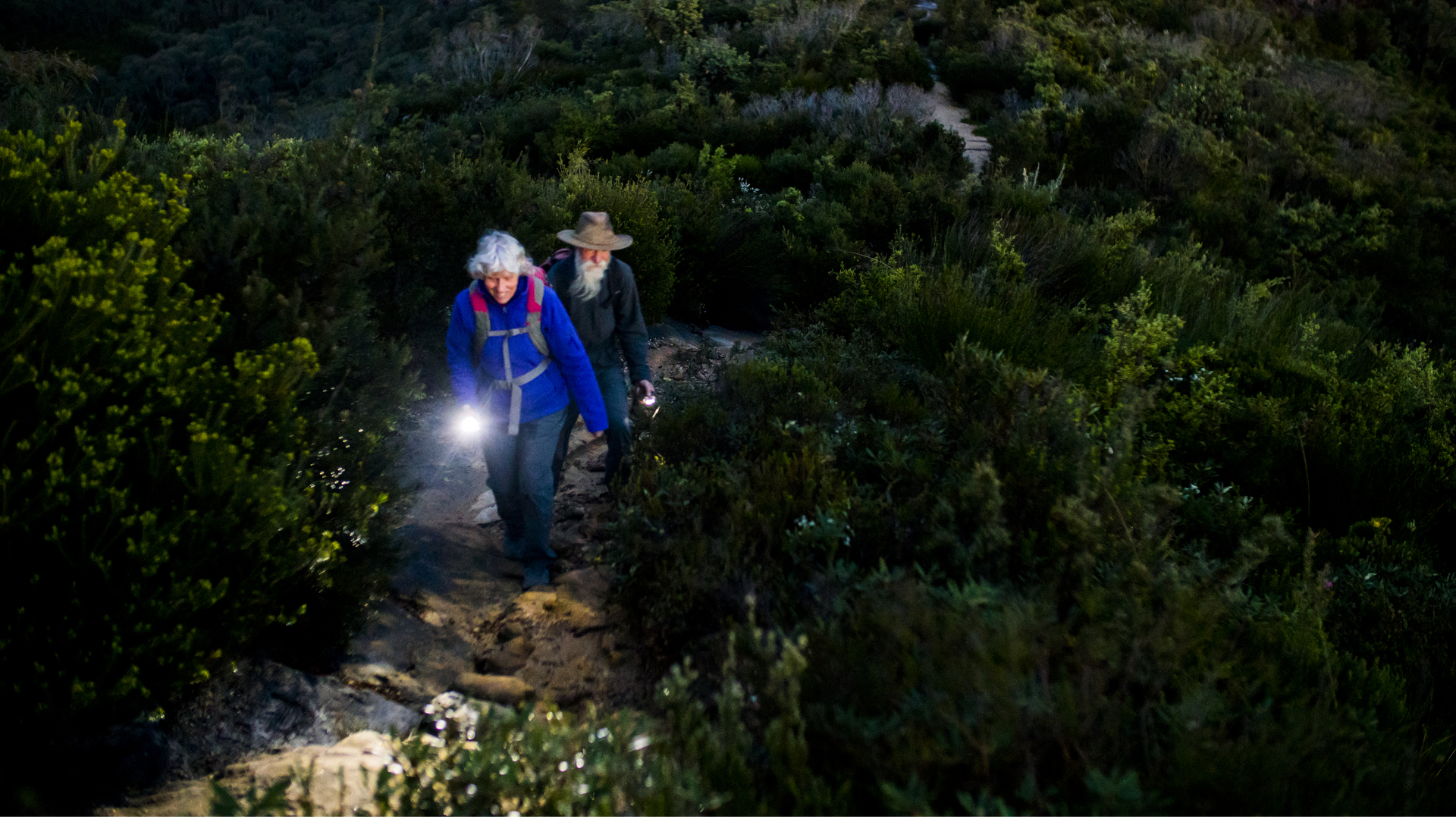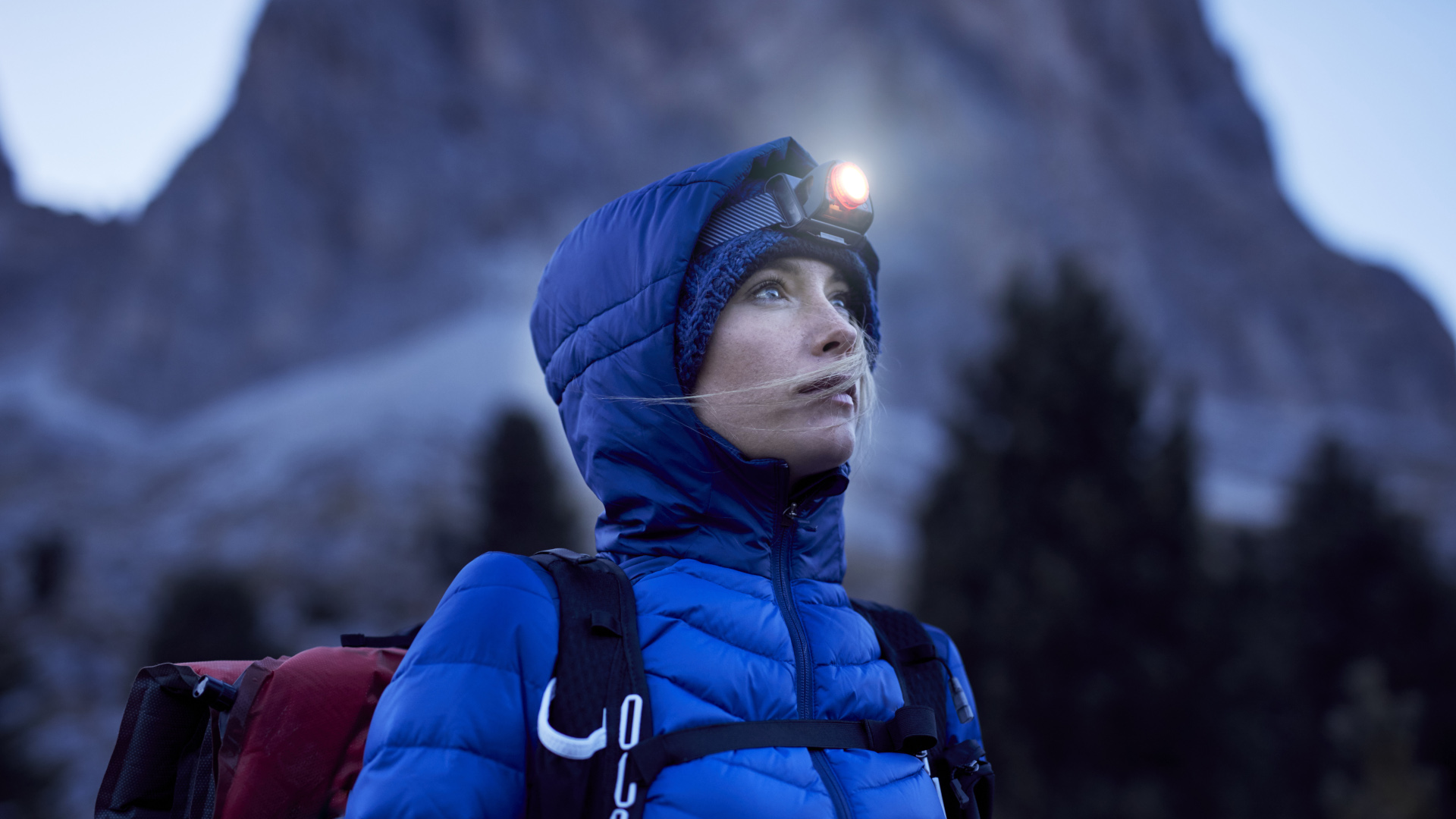Headlamp vs flashlight: which beam is best?
We shed some light on the pros and cons of the headlamp vs flashlight for your nocturnal adventures

Whether you're camping, night walking or running on the trail, when the sun goes down, you're going to need a good light source. Most importantly, you need to be able to illuminate the trail ahead of you and pick up any obstacles around the campfire, and for years, the trusty flashlight was the best option. However, you also want to be able to use both hands when you're rummaging through your camping cooler looking for a cold one, and if you're running, you need to be able to move your arms, which is where the newer headlamp comes in awfully handy (see our guide to the best headlamps for some good options).
But does it render the flashlight obsolete? Which is best for your nocturnal escapades? We take on the battle of the beams, as it were, and shed some light on the pros and cons of the headlamp vs flashlight, and find it’s not quite as clear-cut as you might think.
We’ve all misjudged the time or got lost while on a trail at some point, and if nightfall catches you out, having a source of light makes it a whole lot easier to find your way home. If things really go wrong, you can use a light to signal for help. Plus you never know when you might find a cave to explore. There's no question that carrying a headlamp or flashlight on an adventure is good common sense, the only question is: which one do you need?

Headlamp vs flashlight: practicality
This round would seem to be a pretty easy win for the headlamp – chance for a quick KO, even. With a source of illumination secured on a head strap, you have not one but two hands at your disposal to find or do whatever it is you’re seeking to achieve in the dark. No need to try and hold the torch between your teeth, or under your arm. From full moon hiking with trekking poles and scrambling up steep stony slopes in the gloom, to reading a map on a dark trail or a book in your tent, the positives of a hands-free light source are endless.
Flashlights, of course, need to be carried, leaving you with just one hand free for tasks. However, they can also be shone in any direction, not just the way you are looking, and directed more accurately, and both of these features are useful for signaling. Some people find constantly wearing a headlamp a little uncomfortable, and hate being blinded by their friends who insist on wearing them set to high beam during conversations around the campfire. Handheld flashlights can be easily positioned on a rock or in a tree to illuminate something, or placed under a bottle as a makeshift camping lamp in your tent.
As a side note, it’s worth remembering that if you're camping with kids, they will lose handheld stuff at the drop of a hat, whereas having a headlamp attached to them means you have a fighting chance of finding them in the dark, and not having to buy a new flashlight for every outing.

Headlamp vs flashlight: weight and packability
Headlamps are designed to be as lightweight and low profile as possible, because carrying around too much bulk and heft on your head quickly becomes, quite literally, a pain in the neck. This means they’re also small and light to stick in a backpack.
All the latest inspiration, tips and guides to help you plan your next Advnture!
High-power flashlights are heavy and bulky, but versions for outdoor adventures come in all sorts of sizes, including very small, lightweight versions such as the Olight S1R II Baton and the Ledlenser PX4 Pen Torch, which are even more packable than a headlamp (devoid of the head strap and any external battery casing).
These are perfect to have in a pack or in the pocket of your down jacket as an easy-to-locate emergency light. It’s always a good idea to have a torch of some sort with you when you’re out adventuring, even if you expect to be back well before dark.

Headlamp vs flashlight: functionality and versatility
Most decent headtorches have a range of beam options these days, including the ability to toggle between different levels of brightness (to conserve battery power) and switch from flood (wide, for reading something close to your face and casting light broadly around your feet) to spot (narrow, for picking out details of the trail ahead or illuminating something specific in the mid distance).
They will also have colored light options (usually red) so you can check a map or locate something without completely shattering your night vision or waking up everyone else in the tent, and a pulse feature (a flashing light), which lasts for ages and can be used to alert people to your presence. Some – for example the Lifesystems Intensity 235 – even have a pre-programmed SOS signal setting.
An option offered by many headlamps is a rear red light (predominantly set to pulse), positioned on the back of the head strap, that enables people behind you (especially those driving vehicles) to see you in the dark – a really good safety feature for runners and walkers who venture out on country lanes after dark.
Many (but not all) flashlights also boast most of the beam options above – the Life Systems Intensity 370 Hand Torch is a good example of a versatile highly featured flashlight – but some also have a fully focusable beam, which can be trained on something very specific.
It can also be easier to use a handheld torch for signaling. Some designs, for example the Duronic Hurricane LED torch, are specifically designed so you can quickly turn your flashlight into one of the best camping lanterns around. Larger Night at the Museum-style flashlights can be used for self-defense if required.

Headlamp vs flashlight: range and burn time
With the evolution of ever-brighter and increasingly high-performing LEDs, the best headlamps on the market now have an astonishing range, but this reach does typically come at a higher cost.
Generally speaking, in terms of bang for buck, a flashlight will be capable of packing more battery power and will outshine a headtorch in a comparable price bracket, both in terms of distance and usable time – but it will, of course, be a bulkier beast to carry.
The Ledlenser MT6, for example, has a range of 260 meters, and when switched to low power mode will last for 192 hours, while the more expensive and bigger Ledlenser i18R has a range of 540 meters and a burn time (on low power) of up to 96 hours. Bulkier still, but incredibly bright and very affordable, the Alflash Rechargeable LED Floodlight Torch has a stellar range of up to 800 meters.
Both headlamps and handheld flashlights are available in models that can either be plugged in and recharged, or which take standard batteries – the best permit both, as this allows you to carry spare batteries during multi-day adventures.

Headlamp vs flashlight: durability
Headlamps at the top end of the market are increasingly robust, with some boasting really impressive Ingress Protection (IP) ratings in terms of water and dust proofing, and shock resistance – the Black Diamond Storm, for example, is fully dust and waterproof, and is submergible to 1 meter for up to half an hour, and other models by specialist brands such as Petzl and intended for use by cavers or underground/underwater professionals are even more sturdy (and considerably more expensive).
However, some very affordable flashlights, like the Baton family produced by Olight, are even tougher still, and can put up with even more extended periods of submersion in water, and worse falls, without failing.
It’s another hard round to score, because different brands and models offer very different levels of durability, but the more solid build of handhelds mean that they generally outperform the slightly more delicate design of a headlamp in terms of robustness and longevity – certainly at the more affordable end of the scale.

Headlamp vs flashlight: price
You can spend very little, or an awful lot, on both headlamps and handheld torches – and in both cases you will get what you pay for. If you just want something cheap but dependable to keep in the car, or for occasional use during high summer backyard camping experiences, then a bargain-end flashlight might be your best option.
However, if you do a lot of after dark or underground adventuring, and/or any autumn-winter-spring camping, then it’s really worth investing in the best torch or headlamp you can afford, whether you wear it on your head or hold it in your hand.
| Header Cell - Column 0 | Headlamp | Flashlight |
|---|---|---|
| Practicality | Leaves you with two hands free to do whatever you want | Takes up the use of one hand, or your mouth |
| Weight & packability | Small, light and low profile | Can be lightweight and packable or heavy and bulky |
| Functionality and versatility | Usually wide range of beam options including blinking and different colors for visibility | Usually wide range of beam options including blinking and different colors for visibility, can sometimes be used as a lantern |
| Range and burn time | Increasingly brighter and longer range | Usually capable of packing more battery power and will outshine a headtorch in a comparable price bracket |
| Durability | Headlamps at the top end of the market are increasingly robust, waterproof and dustproof | Some very affordable flashlights are even tougher |
| Price | Runs the gamut | Runs the gamut |
Headlamp vs flashlight: the verdict
By virtue of the high-functionality most models now boast, and the fact that it keeps both hands free during use, we’re big fans of the headlamp, but making a choice between a handheld or a headtorch very much comes down to personal preference and the kind of things you do in the outdoors.
For outdoor active types – night hikers, trail runners, climbers, canoeists, cavers, skiers – it really feels like a no-brainer to go for a head-mounted model that allows you to retain the full use of all your limbs and not have one hand held out in front of you at all times, but there are definitely occasions when a good handheld torch can really shine – during nocturnal wildlife watching for example.
In terms of carrying an emergency, or second, light source, a small handheld torch can be a great option, and you get a lot of glow for your dough with a flashlight.
- Full moon hiking: why hiking at night should be your next adventure

Author of Caving, Canyoning, Coasteering…, a recently released book about all kinds of outdoor adventures around Britain, Pat has spent 20 years pursuing stories involving boots, bikes, boats, beers and bruises. En route he’s canoed Canada’s Yukon River, climbed Mont Blanc and Kilimanjaro, skied and mountain biked through the Norwegian Alps, run an ultra across the roof of Mauritius, and set short-lived records for trail-running Australia’s highest peaks and New Zealand’s Great Walks. He’s authored walking guides to Devon and Dorset, and once wrote a whole book about Toilets for Lonely Planet. Follow Pat’s escapades on Strava here and Instagram here.
